![]()
![]()
![]()
Use LEFT and RIGHT arrow keys to navigate between flashcards;
Use UP and DOWN arrow keys to flip the card;
H to show hint;
A reads text to speech;
43 Cards in this Set
- Front
- Back
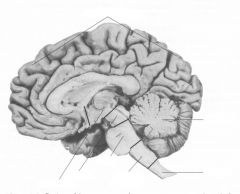
|

|
|
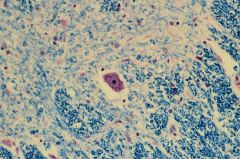
|

cytoplasm with nissl substance = rER
blue = myelin |
|
|
All CNS cell types except ___ are derived from the ___
|
-microglia
-neural tube |
|
|
Origin of microglia?
|
bone marrow
|
|
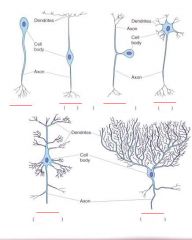
|

Hippocampus: part of cortex
H&E does not tell much about neurons, can’t see axons |
|

|
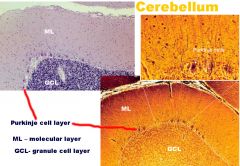
Silver nitrate to see purkinje cells
Cellebellar lesions - ataxia |
|
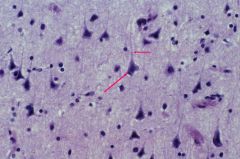
|

Dendrites:
Proximal parts have Nissl substance. More distally, Nissl substance is absent and therefore, dendritic arbors cannot be fully appreciated when one uses Nissl stains |
|
|
Nissl bodies are made up of
|
rER and polysomes
|
|
|
Some neurons, such as Purkinje cells of the cerebellum, have dendrites characterized by short protrusions. These protrusions are called ___ (3 names). They are specialized regions of synaptic contact.
|
spines, thorns or gemmules
|
|
|
Do dendrites display an action potential?
|
No, they display a graded potential, i.e. their membrane potential becomes more positive or more negative depending on input
|
|
|
The terminal arborizations of axons are called
|
telodendria
|
|
|
Neurofilaments:
-relative amount compared to microtubules in axons -function |
Neurofilaments predominate, i.e. are more abundant than microtubules, and are believed important in maintaining axonal diameter;
increased neurofilaments --> increased axonal diameter |
|
|
Fast Axonal Transport:
Microtubule dependent Anterograde component uses ___ as a motor protein Retrograde component uses ___ as a motor protein Substances that disrupt microtubules or that prevent their assembly will prevent or inhibit fast axonal transport |
-kinesin
-dynein |
|
|
___ is material that cannot be digested.
|
Lipofuscin
|
|
|
Rabies virus binds to ___ receptor of motor neurons innervating infected muscle cells
___ transported to cell body where it can replicate |
-acetylcholine
-Retrogradely |
|
|
Toxins such as ___ (3) are retrogradely transported
|
tetanus toxin, a protease, and ricin toxin
|
|
|
At synapse, influx of CA2+ due to depolarization causes what?
|
Neurotransmitter release
|
|
|
After neurotransmitter release, the membrane is taken up/retrieved by ___-coated vesicles
|
clathrin
|
|
|
Gray matter astrocytes
|
protoplasmic astrocytes
|
|
|
White matter astrocytes
|
fibrous
|
|
|
Fibrous astrocytes:
have long slender processes packed with 10nm intermediate filaments that are composed of the protein ___. |
glial fibrillary acidic protein (GFAP)
|
|
|
Protoplasmic astrocytes stain ___ intensely with antibodies to GFAP
|
less
|
|
|
The end-feet of astrocytes line the inner portion of the pia matter to form
|
glia limitans
|
|
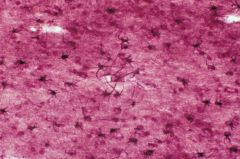
|

Astrocytes
|
|
|
Around the capillaries are astrocytic ___
Experimental studies show that astrocytes induce capillaries to form the ___ |
-endfeet
-blood brain barrier |
|
|
Tumors involving cells derived from ___ are the most common type of primary brain tumor. They comprise 80-90% of all glial tumors in adults.
HAVE A TENDENCY TO BECOME MORE ___ WITH TIME frequently disseminate via the CSF to other regions of the ___, but seldom metastasize to the rest of the body mean survival ___ |
-astrocytes
-ANAPLASTIC -CNS -8-10 months |
|
|
-Chronic demyelinating disease of the CNS
Multiple, focal plaques of demylenization -___, which is myelinated by oligodendroglia, often affected. |
-Multiple Sclerosis (MS)
-Optic nerve |
|
|
Multiple Sclerosis (MS):
-Prevalence 1 in ___ in USA Pathogenesis undetermined May be autoimmune Antibodies to central myelin -Characterized by ___ and relapse -CNS plaques (___) formed by ___ |
-1000
-remission -scars -astrocytes |
|
|
Unilateral visual impairment.
Diplopia (double vision). Paresthesias (pins and needles) Ataxia (unsteadiness) Vertigo (dizziness) Fatigue Paresis (muscle weakness) Dysarthria (speech problems) Mental disturbances |
MS:
Symptoms in declining order of frequency. |
|

|
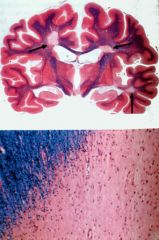
Multiple, focal plaques of demylenization
CNS plaques (scars) formed by astrocytes |
|
|
-When the CNS is injured, the microglial nuclei enlarge and elongate. These cells are then called ___ by pathologist
-Increased damage causes the microglia to become phagocytic. They are then called ___ by pathologists. |
-rod cells
-gitter cells |
|
|
CNS INJURY:
CNS injury in adults causes permanent deficits In adults, CNS regeneration severely limited -Astrocytes react to injury – ___ -Form a ___ that inhibit axonal regeneration -___express protein that prevent axonal growth |
-gliosis
-glial scar -Oligodendroglia |
|
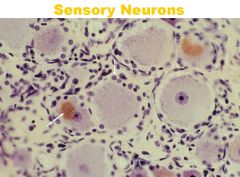
|

|
|
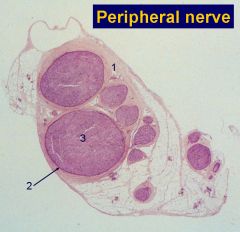
|

|
|
|
Guillan-Barre´ Syndrome:
Acute inflammatory polyradiculoneuropathy Affects ___ myelin only Usually bilateral, symmetrical, motor weakness -Evidence of ___ (3) around axons May be an autoimmune disease Severe cases can lead to death Most cases resolve in 2-4 weeks. |
-PNS
-T-cells, plasma cells and macrophages |
|
|
Peripheral Nerve Regeneration:
When injured, peripheral nerves can regenerate Regenerate best when ___, i.e. when CT sheaths intact ___ play a critical role by - Becoming phagocytic Synthesizing essential growth-promoting factors and cytokines |
-crushed
-Schwann cells |
|
|
Peripheral Nerve Regeneration:
Average rate of regeneneration |
1-3mm/day
|
|
|
When an axon is severed, the neuronal cell body undergoes a number of structural and molecular changes.
These changes are generally believed to be a neuronal response to a loss of ___. These changes reflect an attempt by the neuron to regenerate its severed axon |
-target-derived neurotrophic factors
|
|
|
When an axon is severed (axotomy), the neuron exhibits the ___.
-The cell body ___. -There is a dissolution of Nissl substance called ___. -The nucleus moves to an ___ position. These changes begin within 24-48 hours and reach a peak at about 2 weeks. |
-axonal reaction
-swells -chromatolysis -eccentric |
|
|
Regenerative response:
___ are among genes up-regulated - Needed for growth cone and axon regeneration -___ genes and genes associated with synaptic transmitters are down-regulated. |
-Actin and tubulin
-Neurofilament |
|
|
Severed axon:
___ portion degenerates back to the next node of Ranvier - retrograde degeneration ___ portion begins to degenerate because separated from synthetic machinery of the cell anterograde or ___ degeneration |
-Proximal
-Distal -Wallerian |
|
|
The axonal reaction:
Biochemical changes - -Decrease in synthesis of less-essential proteins - ___ Increase in synthesis of proteins needed for axonal regeneration - |
-neurofilament proteins, transmitter proteins
-tubulin and actin proteins |
|
|
Within hours of injury, the severed axon produces a ___.
It is a motile structure that has a concentration of receptors for ___ |
-growth cone
-neurotrophic factor and laminin |

